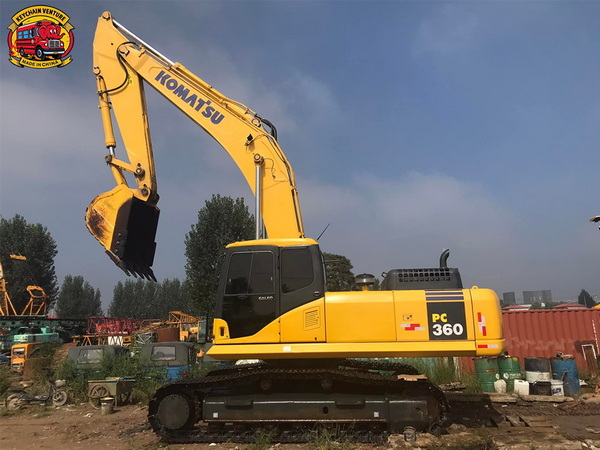Views: 222 Author: Amanda Publish Time: 2025-09-29 Origin: Site








Content Menu
● Introduction to GPS on Excavators
● Benefits of Using GPS on Excavators
● How GPS Systems Work on Excavators
● Step-by-Step Guide to Using GPS on Excavators
>> Prepare the Excavator and System
>> Begin Excavation with GPS Assistance
>> Monitor and Make Adjustments
>> Final Verification and Reporting
● Using GPS on a Used Excavator
● Advanced GPS Features for Excavators
● Overcoming Common Challenges With GPS on Excavators
>> Signal Interference and Loss
>> Operator Adoption and Training
>> Software Compatibility Issues
● FAQ
>> 1. How accurate is GPS on an excavator?
>> 2. Can GPS systems be retrofitted on any used excavator?
>> 3. Does GPS reduce the need for manual surveying on site?
>> 4. What kind of maintenance does a GPS system require?
>> 5. Is specialized operator training necessary for GPS excavators?
KeyChain Venture Co., Ltd. is a leading commercial vehicle supplier in China, dedicated to providing high-performance bus and heavy truck solutions to customers worldwide. As the construction and earthmoving industries evolve, technology like GPS integration on excavators has become essential for improving efficiency, accuracy, and productivity on job sites. This article will guide you through how to effectively use GPS on an excavator, especially highlighting the benefits when working with a used excavator, and how this technology can enhance overall operational performance.

Global Positioning System (GPS) technology has revolutionized many industries, and construction is no exception. On excavators, GPS systems provide real-time guidance for operators to perform precise digging, grading, and excavation work. Whether you are working with a brand-new or a used excavator, understanding how to leverage GPS technology will maximize your job site outcomes.
Today's GPS systems on excavators combine satellite positioning with advanced sensors and software, turning traditional digging methods into a highly accurate, automated process. This increases operational efficiency, reduces material waste, and lowers costs.
There are numerous advantages to using GPS systems on excavators:
- Increased Digging Accuracy: With GPS guidance, operators can dig or grade land with centimeter-level precision, reducing errors and ensuring project specifications are met.
- Reduced Rework: GPS minimizes mistakes by providing clear guidance, which means less re-excavation or over-digging, saving time and resources.
- Time Efficiency: Operators can rely on GPS data instead of manual measurements, drastically speeding up the workflow and project completion.
- Cost Savings: By optimizing excavation processes, GPS reduces material waste, fuel consumption, and labor costs.
- Enhanced Safety: Modern GPS systems often include warnings about underground utilities and restricted areas, keeping operators and on-site workers safe.
- Improved Data Management: GPS systems can log excavation data, which helps with project documentation and quality assurance.
GPS systems on excavators use a combination of hardware and software elements to deliver precise positioning:
- Satellite Antenna: Receives signals from GPS satellites orbiting the Earth, which provide location data based on triangulation.
- On-Board Computer: Processes the satellite data alongside input from sensors deployed on the excavator, calculating the exact position of the boom, stick, and bucket.
- Display Monitor: A user interface inside the cab shows the operator real-time data regarding excavation depth, horizontal position, and slope angles.
- Hydraulic and Positional Sensors: These measure the angles and movement of the excavator's various components, enabling the GPS system to understand where the bucket is relative to the ground.
All these elements work together to create a 3D map of the excavation site and guide operators toward precise digging according to project plans.
- Conduct a thorough inspection of your excavator, whether it is a new model or a used excavator. Make sure all mechanical components are functioning properly.
- Ensure GPS antennas and sensors are correctly mounted and securely connected.
- Power on the system and wait for the GPS unit to acquire satellite signals, which may take several minutes depending on location and weather.
- Upload the digital site designs or CAD files into the GPS system. These files contain the excavation plans and elevation details.
- Set parameters like excavation depth, slope requirements, and boundary limits.
- Verify data accuracy with your project engineer or surveyor before beginning work.
- Perform system calibration as instructed by the GPS software. This usually includes moving the boom and bucket through multiple positions to establish references.
- Proper calibration ensures that the GPS accurately tracks machine movements and provides reliable guidance.
- Monitor the display inside the cab to follow excavation instructions.
- The screen will show exact positioning information, such as how deep or how far to dig, along with alerts for any potential issues.
- Use the information to operate precision digging, maintaining alignment with project plans.
- Regularly check GPS data throughout the excavation process to ensure accuracy.
- Make any necessary changes to digging strategy based on site conditions or updated project needs.
- Maintain communication with your site manager to confirm progress and report any discrepancies.
- Upon completion, conduct a final verification using GPS to check that excavation matches the project specifications.
- Export the logged excavation data and share it with project stakeholders for quality assurance and documentation.

Many companies find purchasing a used excavator equipped with GPS to be a cost-effective way to upgrade operations without investing heavily in new equipment. To make the most of GPS on a used excavator:
- Perform a comprehensive evaluation of the GPS unit's condition, including hardware integrity and sensor effectiveness.
- Assess if the software installed is compatible with your project needs; update or upgrade the system if necessary.
- Provide specialized operator training for those new to the specific brand or GPS interface on the used excavator.
- Regular maintenance is especially crucial; sensors and antennae should be inspected often to avoid breakdowns or data inaccuracies.
Modern GPS technology for excavators offers advanced functionality that takes operational efficiency to the next level:
- 3D Design Integration: Enables operators to work using fully three-dimensional project models, facilitating complex grading and trenching tasks.
- Machine Control Automation: Integrates GPS with the machine's hydraulic system to automatically control boom and bucket movements based on site design, reducing operator strain and error.
- Data Logging and Reporting: GPS systems can save detailed records of the excavation process, helping project managers evaluate progress and maintain compliance with regulations.
- Remote Monitoring and Fleet Management: Supervisors can monitor excavator performance, location, and work progress remotely via IoT-enabled systems, improving overall project supervision.
Urban areas with tall buildings or heavily forested sites can disrupt satellite signals. To mitigate this:
- Use GPS correction services such as Real-Time Kinematic (RTK) or Differential GPS (DGPS) to improve accuracy.
- Set up additional base stations on-site to boost signal reception.
Even the best GPS system is ineffective without skilled operators:
- Offer comprehensive training programs covering system setup, navigation, troubleshooting, and interpretation of data.
- Provide refresher courses to maintain high proficiency levels.
Different projects might require different file formats:
- Ensure your GPS system is compatible with widely used digital formats such as DXF, DWG, or LandXML.
- Regular software updates can solve compatibility and functionality issues.
GPS systems have critical components that require upkeep:
- Establish routine maintenance schedules for sensor calibration and hardware inspections.
- Keep software updated and perform diagnostic checks to detect issues early.
Incorporating GPS technology into excavator operations—whether using new or used excavators—significantly boosts precision, productivity, and safety on construction projects. KeyChain Venture Co., Ltd. recognizes the importance of integrating advanced GPS systems into its commercial vehicle offerings to provide clients with solutions that meet the highest standards. From improved digging accuracy to real-time project management, GPS transforms an excavator into a smart machine capable of delivering optimal results while reducing costs and operational risks. Investing in GPS-equipped excavators is a decisive step toward future-proofing your construction endeavors.

Modern GPS systems on excavators can achieve centimeter-level accuracy, making them highly reliable for detailed excavation and grading tasks.
Most used excavators can be upgraded with GPS systems; however, compatibility depends on the machine's age and technology. Expert installation and calibration are essential.
Yes, GPS provides real-time location and depth data, significantly reducing manual surveying requirements, though occasional surveys are still standard practice.
Regular calibration, sensor and antenna inspections, software updates, and hardware upkeep are necessary to maintain accuracy and reliability.
Absolutely. Operators need training to use GPS interfaces effectively and respond to system alerts to maximize technology benefits.